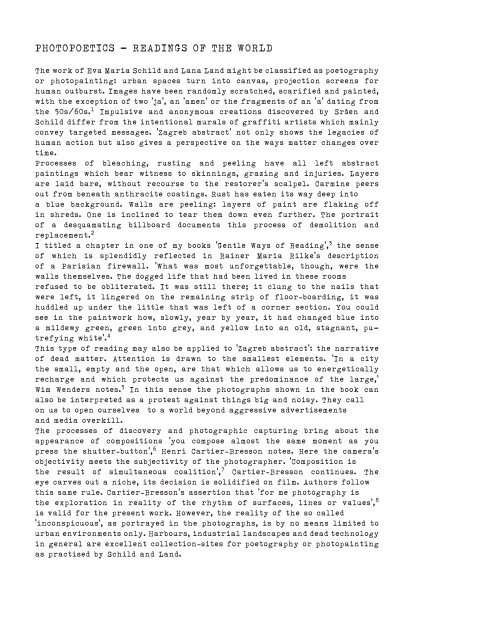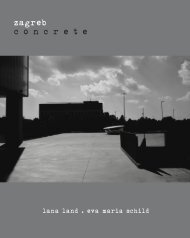zagreb abstract
- No tags were found...
You also want an ePaper? Increase the reach of your titles
YUMPU automatically turns print PDFs into web optimized ePapers that Google loves.
PHOTOPOETICS - READINGS OF THE WORLD<br />
The work of Eva Maria Schild and Lana Land might be classified as poetography<br />
or photopainting: urban spaces turn into canvas, projection screens for<br />
human outburst. Images have been randomly scratched, scarified and painted,<br />
with the exception of two ‘ja‘, an ‘amen‘ or the fragments of an ‘a‘ dating from<br />
the 50s/60s. 1 Impulsive and anonymous creations discovered by Sršen and<br />
Schild differ from the intentional murals of graffiti artists which mainly<br />
convey targeted messages. ‘Zagreb <strong>abstract</strong>‘ not only shows the legacies of<br />
human action but also gives a perspective on the ways matter changes over<br />
time.<br />
Processes of bleaching, rusting and peeling have all left <strong>abstract</strong><br />
paintings which bear witness to skinnings, grazing and injuries. Layers<br />
are laid bare, without recourse to the restorer’s scalpel. Carmine peers<br />
out from beneath anthracite coatings. Rust has eaten its way deep into<br />
a blue background. Walls are peeling: layers of paint are flaking off<br />
in shreds. One is inclined to tear them down even further. The portrait<br />
of a desquamating billboard documents this process of demolition and<br />
replacement. 2<br />
I titled a chapter in one of my books ‘Gentle Ways of Reading‘, 3 the sense<br />
of which is splendidly reflected in Rainer Maria Rilke’s description<br />
of a Parisian firewall. ‘What was most unforgettable, though, were the<br />
walls themselves. The dogged life that had been lived in these rooms<br />
refused to be obliterated. It was still there; it clung to the nails that<br />
were left, it lingered on the remaining strip of floor-boarding, it was<br />
huddled up under the little that was left of a corner section. You could<br />
see in the paintwork how, slowly, year by year, it had changed blue into<br />
a mildewy green, green into grey, and yellow into an old, stagnant, putrefying<br />
white‘. 4<br />
This type of reading may also be applied to ‘Zagreb <strong>abstract</strong>‘: the narrative<br />
of dead matter. Attention is drawn to the smallest elements. ‘In a city<br />
the small, empty and the open, are that which allows us to energetically<br />
recharge and which protects us against the predominance of the large,‘<br />
Wim Wenders notes. 5 In this sense the photographs shown in the book can<br />
also be interpreted as a protest against things big and noisy. They call<br />
on us to open ourselves to a world beyond aggressive advertisements<br />
and media overkill.<br />
The processes of discovery and photographic capturing bring about the<br />
appearance of compositions ‘you compose almost the same moment as you<br />
press the shutter-button‘, 6 Henri Cartier-Bresson notes. Here the camera’s<br />
objectivity meets the subjectivity of the photographer. ‘Composition is<br />
the result of simultaneous coalition‘, 7 Cartier-Bresson continues. The<br />
eye carves out a niche, its decision is solidified on film. Authors follow<br />
this same rule. Cartier-Bresson’s assertion that ‘for me photography is<br />
the exploration in reality of the rhythm of surfaces, lines or values‘, 8<br />
is valid for the present work. However, the reality of the so called<br />
‘inconspicuous‘, as portrayed in the photographs, is by no means limited to<br />
urban environments only. Harbours, industrial landscapes and dead technology<br />
in general are excellent collection-sites for poetography or photopainting<br />
as practised by Schild and Land.<br />
The experienced eye may draw comparisons with Lucio Fontana’s perforated<br />
and slashed canvas ‘Bucchi e Taglie‘. Clearly, the elevated triangles<br />
point to the houses of Paul Klee, as do the fine lines on a blue rust<br />
coated surface. Marc Chagall’s chicken may also be envisaged as well as<br />
balls of wool and tangled, blue and beige yarn. Ways of interpreting are<br />
limitless. Sometimes, the motives support the photopaintings by presenting<br />
themselves in a way that is already framed. Taken together, a spectrum<br />
of photopoetics unfolds, which stimulates new ways of reading. Schild<br />
and Land visualize what Rilke put into words and what Wenders plead for.<br />
Franziska Bollerey<br />
1 Cf. I.a.: Kehrer, Martin Ulrich: Stadt Alphabet Barcelona, Wien 2013<br />
2 Cf.: Affiches&Grafitti. In: Sawyer, Erroll: City Mosaics, Amsterdam 2010, pp. 21-57<br />
3 Bollerey, Franziska: Mythos Metropolis. Myth Metropolis, Berlin 2006<br />
4 Rilke, Rainer Maria: Schriften in Prosa. Zweiter Teil. Die Aufzeichnungen des Malte Laurids Brigge,<br />
Leipzig 1930, p. 58<br />
5 Wenders, Wim: The act of seeing. Essays, Reden, Gespräche, Frankfurt am Main 1992, p. 124<br />
6 Cartier-Bresson, Henri: Über das Photographieren. In: „Du“, june 6th 1958, p. 56<br />
7 Ibid.<br />
8 Ibid.



